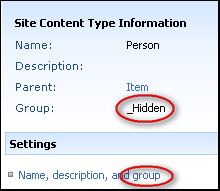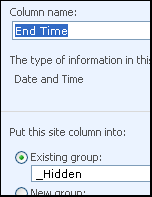You may know that several out-of-the-box Content Types belong to the group _Hidden.

This means that when you first start using the site, you cannot create child Content Types based on these types. Also, if you want to aggregate Blog Posts with a Content Query Web Part, for instance, you will need to expose the content type to the web part’s drop down configuration menus. This table lists the OOB Content Types that belong to the _Hidden group.
|
Name |
Ctype |
“
|
Administrative Task |
0x010802 |
|
Comment |
0x0111 |
|
DomainGroup |
0x010C |
|
Event |
0x0102 |
|
Office Data Connection File |
0x010100629D00608F814dd6AC8A86903AEE72AA |
|
Person |
0x010A |
|
Post |
0x0110 |
|
RootOfList |
0x012001 |
|
SharePointGroup |
0x010B |
|
Universal Data Connection File |
0x010100B4CBD48E029A4ad8B62CB0E41868F2B0 |
|
User Workflow Document |
0x010107 |
|
Wiki Page |
0x010108 |
|
Workflow History |
0x0109 |
|
Workflow Task |
0x010801 |
“
I listed the hidden ctype above because you can get to the settings quickly by using this path: http://<server_name>/_layouts/ManageContentType.aspx?ctype=<ctype>

Then click “Name, description, and group” to change the group. Since _Hidden does not appear in the dropdown, this is a one-way change without some sort of hack. I suggest moving these to a new group that you can monitor–you really don’t want someone to change the base Content Types, just creating their own child types. The same thing can happen to Site Columns. Next time you need an OOB Site Column for another Content Type or a Calculated Column and can’t find it, check to see if it’s actually in a _Hidden group. For example, if you create a child of Event, the field labeled Start Time is actually “StartDate” which you can use in a formula but End Time (internal name “EndDate”) is hidden.

After changing this group to a visible one, you can use End Time in calculations like =[End Time]-[Start Date].
